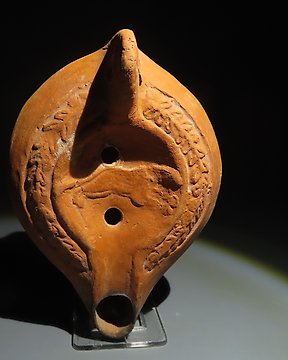
Ancient Roman Terracotta Oil Lamp. 1st-3rd century AD. 13 cm length.
No. 83938069

No. 83938069

ITEM: Oil lamp
MATERIAL: Pottery
CULTURE: Roman, Holy Land
PERIOD: 2nd - 3rd Century A.D
DIMENSIONS: 18 mm x 42 mm x 65 mm
CONDITION: Good condition
PROVENANCE: Ex French private collection, acquired before 1980s
Roman oil lamps featuring dolphin motifs are a fascinating aspect of ancient Roman art and culture. Dolphins held significant symbolic value in Roman society, often associated with themes of protection, fertility, and guidance. Depictions of dolphins were common in various forms of Roman art, including mosaics, sculptures, and pottery, reflecting the reverence and admiration for these creatures. In the context of oil lamps, dolphin motifs were particularly popular during the Roman Imperial period, around the 1st to 3rd centuries AD, when the use of oil lamps became widespread across the Roman Empire.
The incorporation of dolphin imagery into oil lamps served both functional and decorative purposes. Dolphin-shaped handles or relief designs adorned the lamps, adding an aesthetic appeal to the utilitarian objects. These lamps were crafted from materials such as terracotta, bronze, or pottery, with intricate detailing on the surface. The presence of dolphins on oil lamps not only enhanced their visual allure but also imbued them with symbolic significance. Dolphins were believed to possess protective qualities, and their inclusion on oil lamps may have been seen as a way to invoke these protective powers in the household or sacred spaces where the lamps were used.
Furthermore, the use of dolphin motifs on oil lamps may have reflected the Roman fascination with the sea and maritime life. Dolphins were commonly associated with the god Neptune, the Roman deity of the sea, and were often depicted alongside him in art and mythology. By incorporating dolphin imagery into everyday objects like oil lamps, Romans may have sought to evoke a sense of connection with the sea and its associated symbolism of fertility, abundance, and protection.
Comes with Certificate of Authenticity and Export license
If you bid outside the European Union and win the item, we will have to apply for an export licence for your country and shipping will take 3 to 5 weeks.
How to buy on Catawiki
1. Discover something special
2. Place the top bid
3. Make a secure payment